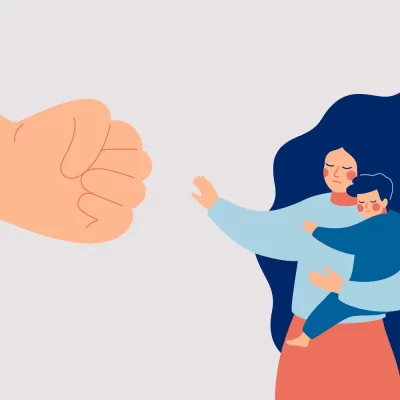Has your partner ever been out of control emotionally during an argument that lead to name-calling, demeaning language, or gaslighting?
Has your partner experienced episodes of rage or anger that have lead to physical aggression, such as hitting, pushing, or throwing objects?
If you answered yes to either of these questions, you may be experiencing reactive abuse.
Reactive abuse is a type of behavior that can occur in relationships when one or both parties are feeling hurt, threatened, or powerless. This behavior may involve name-calling and other verbal insults, threatening body language, or physical aggression.
Whether from a friend, family member, partner, or boss, reactive abuse can cause a ripple effect of broken trust, emotional issues, and even physical harm throughout your life. It’s important to understand that the cycle of reactive abuse can be broken by understanding how it works and finding healthier ways to respond when emotions run high.
This article will explore the types of reactive abuse in relationships, the signs to look out for and provide strategies for breaking the cycle of reactive abuse.
Defining Reactive Abuse
Reactive abuse is a type of behavior that occurs in relationships when one or both parties are feeling hurt, threatened, or powerless. This type of abusive behavior can range from verbal insults to physical aggression, with the intent of causing distress in another person.
Unlike other forms of abuse, reactive abuse doesn’t always need an underlying motive, such as power and control. Instead, reactive abuse can often be an exaggerated emotional response to an emotional trigger caused by something the other person said or did. With that said, power dynamics can still play a role in the motives of the abuser.
The Different Types of Reactive Abuse
Understanding the different types of reactive abuse in relationships is pivotal in recognizing and addressing them to prevent the abuse from continuing or worsening.
Different Types of Reactive Abuse include:
Verbal Insults: Name-calling, humiliation, demeaning language, and other hurtful words are verbal insults that can be used as a form of reactive abuse.
Threatening Body Language: This type of reactive abuse includes aggressive body language such as clenching fists, raising a voice, and pointing fingers.
Physical Aggression: Reactive abusers may also lash out physically by hitting or throwing objects. According to the National Coalition Against Domestic Violence, on average, nearly 20 people per minute are physically abused by an intimate partner in the United States. This equates to more than 10 million women and men per year.
Manipulation Tactics: Manipulators may use guilt-tripping or gaslighting to control the other person in the relationship.
These types of behavior can cause immense emotional damage and distress to those who experience them.
The Dynamics of Reactive Abuse
The dynamics of reactive abuse are complex and often involve elements of power and control. The abuser might feel powerless in the relationship, leading to them lashing out through verbal insults or physical aggression.
On the other hand, the abused person might also feel powerless because they don’t know how to respond or stop the cycle of abuse. This feeling of powerlessness can lead them to either give in to the abuser’s demands or stay silent.
Regardless of which party is in control, it is essential to recognize that reactive abuse can become a pattern if both parties do not learn how to break the cycle. Therefore, understanding the dynamics of power and control in your relationship is essential for breaking the cycle.
Although it is widely thought that the abuser is the one who needs to change for abuse to stop, both parties in the relationship have the ability and responsibility to break the cycle. The abuser must learn how to recognize and control their triggers, while the abused person must understand how to effectively respond without fear of further abuse or how to remove themselves from the threat safely.
Recognizing The Signs
To prevent this type of abuse, you must be aware of the red flag signs to identify abuse before it escalates into something more serious.
Red flag signs of reactive abuse include:
- Unexplained outbursts of anger or rage
- Name-calling and other demeaning language
- Threatening body language, such as raised fists or clenched fists
- Physical aggression, such as hitting, pushing, or throwing objects
- Manipulation tactics such as guilt-tripping or gaslighting
Many of these signs can overlap with other types of abuse. When you consider the reactive nature of the abuser’s motive, it can show whether it is regarded as this type of abuse.
Am I Being Abused?
Sometimes, it can be hard to believe you are or have been abused, especially if you have experienced it for a long time and if your abuser has narcissistic qualities. You may convince yourself that their behavior is normal or that you deserve their words and actions, so there is nothing wrong with it.
Remember: There is no scenario where abuse is healthy.
Every one of us has issues in our life. Perhaps we’ve had a bad experience from school or work, mental programming from childhood that affects how we see ourselves now, or something traumatic that has stayed inside our minds for years. It is normal for the need to process the past to be a healthier person inside and out. Although it is true we are all works-in-progress, it is not okay for someone to seek power and relieve their pain by hurting others. That is abuse, and you deserve better.
Below is a list of common scenarios of reactive abuse. Take note if any of these resonate with you and your experiences.
Common scenarios of reactive abuse include:
- Someone frequently raises their voice or points fingers during an argument.
- One person belittling the other in public or private.
- Threats of violence made towards the other person or their belongings.
- Saying things to make the other person feel guilty, ashamed, or inferior.
- Physically blocking another from leaving a room or an area.
- Making threats of physical harm, such as punching walls or throwing objects.
- Using manipulation tactics to get the other person to do what they want.
- Refusing to listen or respond to the other person’s feelings and opinions.
- Isolating the other person from friends and family.
Although reactive abuse can look drastically different in each occurrence, these common scenarios paint a thorough picture of some typical ways it can play out. If you experience any of these situations, know you are experiencing abuse.
Understanding the Cycle of Reactive Abuse
The cycle of reactive abuse usually follows a predictable pattern. The pattern is as follows:
- The Trigger Event: An event or situation that causes the abuser to feel powerless or frustrated triggers their reaction, which leads to an outburst of rage.
- Emotional Navigation: The abused person person may try to calm the abuser down and navigate the situation, either out of fear or obligation.
- The Apology: The abuser may apologize afterward for their aggression and promise not to repeat it – this is a common tactic to avoid accountability.
- The Acceptance: In this stage, the abuser’s behavior and apology are accepted. However, the underlying issues remain unresolved – leading to the cycle repeating itself in the near future.
Does this cyclical abusive pattern sound familiar to you? You may have gone through this pattern once or hundreds of times without knowing it, but now that you see it, you can better recognize it in the future as it happens. This knowledge is a critical part of breaking the cycle.
In addition to the pattern of reactive abuse, let’s discuss the common triggers that can escalate someone to be abusive.
Common triggers for this type of abuse are:
- Financial Insecurity
- Fear of abandonment
- Feeling ignored or unappreciated
- Jealousy or envy of another person’s successes
- A lack of personal boundaries
Next, let’s talk about the long-term effects of abuse.
Long-term effects of reactive abuse on mental health include:
- Anxiety
- Depression
- Low self-esteem
- Substance abuse
- Post-traumatic stress disorder (PTSD)
- Difficulty trusting others or forming relationships
- Suicidal thoughts or tendencies
Reactive abuse can also have a lasting impact on one’s physical health, as the body is constantly exposed to high stress levels. This can lead to physical ailments such as headaches, chronic fatigue, digestive issues, and trouble sleeping, thus impacting your overall quality of life.
Important: Document Everything. Record every instance of abuse, including date, time, location, and any physical proof such as photos, emails, text messages, or audio recordings (if available). This will help to build a case should you need it in the future.
Breaking the Cycle
Breaking the cycle of reactive abuse includes a couple of different paths. You do not have to stay with your abuser and work on the relationship. It is okay to get away from them, especially when the abuse is severe and causes fear.
In some instances, it is known between both people that the abuse is not intentional and that the abuser does not want to abuse. This usually occurs in cases where physical violence is not present. When the abuser sincerely wants to work on their deep-rooted issues, a person may consider staying in the relationship to work toward creating a healthier one.
If you want to stay:
Here are some practical steps you can take to start breaking the cycle in your relationship to move toward a healthier relationship dynamic:
- Recognizing Triggers: Learn how to recognize triggers for abuse in yourself and your partner or family member so that you can try to prevent outbursts before they happen. Once triggers are identified, it is up to that person to work through why that trigger is so strong. This can include many things, like seeking counseling to process it further, exercising or meditating to relieve stress, or learning how to empower themselves so they don’t have to overpower others. Remember: Your partner’s triggers are not your fault. Although you can help ease the pain of the triggers or exacerbate them, it is their responsibility to heal from them.
- Set Clear Boundaries: This is important for both parties so that you can better understand what is expected from each other and are held accountable to those expectations. Boundaries help set clear expectations of what is and isn’t acceptable in the relationship (which can include acts of abuse) and allow you both to create a relationship that works best for both of you.
- Emphasize open communication and active listening: A relationship in which you can clearly communicate is essential to a healthy relationship dynamic. Make sure you both express your thoughts, feelings, and concerns without judgment or blame.
- Seek counseling or therapy: Talk to a therapist or counselor on your terms or with your abuser if possible. A professional can help to provide tools and strategies to cope with emotional distress to prevent future abuses and help process the aftermath of prior events.
- Self-Care: Self-care is an act of love; if you have experienced abuse, you must show yourself some love and care. Make sure to carve out time for yourself for things that help to restore your energy and bring joy to your life. Getting enough sleep, exercising regularly, or meditating will help build your resilience and strength to heal and recover from abuse.
- Find a Safe Space if you need help: If all else fails, don’t be afraid to reach out for support from a friend, family member, or a domestic violence advocate. Even if you want to stay in your relationship, sometimes you need space from your partner. Find one person or a group of people you can call, text, or visit when space is required to diffuse a situation so you can receive love and support.
If you want to leave:
For many who suffer abuse, staying in the relationship is not an option. When the abuse is so severe that it’s a matter of physical safety, you must get out of that situation ASAP.
Here are tips for getting out of your abusive relationship safely:
- Create an Escape Plan: Prepare a plan for leaving the situation in the safest way possible so that you are ready if it comes to that. This could include hiding a go-back of necessary items, paperwork, money, medication, or anything else you may need when leaving quickly. If you have children, take birth certificates or make copies of existing documents in your go-bag. If you need help or resources such as shelters and hotlines, list those on paper or in a note on your phone.
- Call Crisis Helplines: Reach out to a crisis helpline or hotline for advice and support from a trained professional. They can help provide resources and information on how to stay safe in the present and guide your abuser in the future. This could include housing, food, or other necessities while you leave your abusive situation.
- Use Your Documentation of Abuse: If you have recorded any instances of abuse, keep that information with you. This can help if you press charges or request a restraining order against your abuser. As mentioned earlier, this information can include the date, time, and location of abuse and any physical proof such as photos, emails, text messages, or audio recordings (if available).
- Create Safety Nets: Make sure you have access to your resources and funds for safety purposes. Set aside bank accounts with money and ensure your credit cards are in your name only.
- Build a Support System: Reach out to trustworthy friends or family members you can stay with when leaving the situation. Make sure to have a list of people willing to provide a place for you if needed.
- Seek professional help: Speak to a counselor or domestic violence advocate on what steps should be taken and what resources are available in your area to safely assist in transitioning out of an abusive relationship. Also, your counselor can help you cope with the stress of leaving an abusive situation. Once you go, the blinders you wore to help you endure the abusive relationship come off, which can leave you with a heavy feeling of finally acknowledging the severity of the situation. A counselor will play a crucial part in processing your experiences.
Breaking the cycle of reactive abuse takes courage, which can be challenging to conjure up when you’ve been abused. Still, it’s an essential step towards healing and creating healthier relationships.
Remember that you do not have to go through this alone, and that support is available should you need it.
Can I Heal and Move Forward?
Yes, it is entirely possible to process your experiences and feel healthy and whole again.
Take your time to heal from the pain of abuse because everyone’s healing process is different, and there is no set timeframe for processing these experiences. Allow yourself to feel all of your emotions without judgment or guilt. With time, patience, and practice, you can find a strong sense of self and the confidence to move forward without fear of future abuse.
Above all else, remember that you are worthy of love and respect, even if someone else has failed to show it to you. You can find a healthier relationship by taking steps towards healing and self-care. You deserve to be surrounded by positive, supportive people who can help you become the best version of yourself.
Conclusion
Reactive abuse is a destructive pattern of behavior that must be addressed to create healthier, safe relationships. It is possible to heal and move forward from these experiences, but it takes time, dedication, and self-care.
If you are in an abusive relationship, always prioritize your safety and reach out for help from crisis hotlines, domestic violence advocates, and your support system to secure a safe space to escape. With courage and dedication to healing, you can break the cycle of reactive abuse and create healthier relationships.
Mental health professionals can provide guidance and resources on how to build healthier relationships and help individuals cope with the trauma of an abusive relationship. If you would like to speak to a counselor about your experiences with trauma or abuse, call us or schedule an appointment to get started. We offer online telehealth appointments, making it easier for you to seek help without needing to go to a physical location for the help you need.
You are not sentenced to a life of abuse. Please utilize our lists above for how to break the cycle, or call your national domestic violence hotline. Your safety is the highest concern, so please seek help ASAP if you are in danger.
If you are in the US and need to talk to someone from the National Domestic Violence Hotline, call 1-800-787-3224, text START to 88788, or click here to go to their website for their on-site chat option. If you would like more specific resources for your area, check out their Local Resource tool, which allows you to select what type of resource you need and the location you are searching for.
If you are outside the US, check with your local domestic violence hotline, community resource center, or emergency services number for further help when your safety is at risk.








